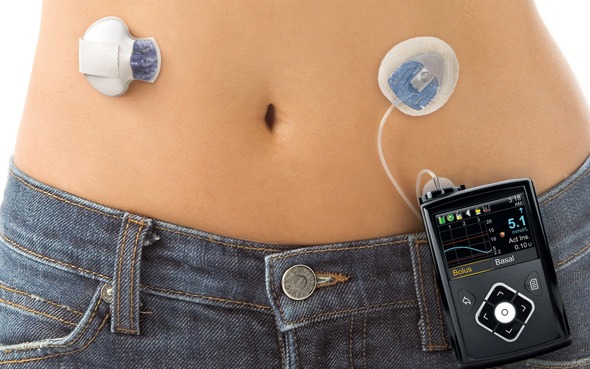- +91 87790 01598
- healthcentred@gmail.com
- Mon - Fri: 10.00 – 13.00 / Closed on Weekends
Home » Insuline Pump

At our clinic, we provide the facility of managing a patient on insulin pump therapy, help him/her achieve his blood sugar goals and to remain complication-free.
An insulin pump is a small device about the size of a small cell phone that is worn externally and can be discreetly clipped to your belt, slipped into a pocket, or hidden under your clothes.
The insulin pump is not an artificial pancreas (because you still have to monitor your blood glucose level), but pumps can help to achieve better control, and many people prefer this continuous system of insulin delivery over injections.
Pumps can be programmed to release small doses of insulin continuously (basal), or a bolus dose close to mealtime to control the rise in blood glucose after a meal. This delivery system most closely mimics the body’s normal release of insulin.
An insulin pump delivers rapid-acting insulin 24 hours a day through a catheter placed under the skin. Your insulin doses are separated into:
• In a steady measured and continuous dose (the “basal” insulin)
• As a surge (“bolus”) dose, at your direction, around mealtime.
• Correction or supplemental doses
Doses are delivered through a flexible plastic tube called a catheter. With the aid of a small needle, the catheter is inserted through the skin into the fatty tissue and is taped in place.
The main advantages of pump therapy are:
• Increased flexibility in lifestyle.
• Predictable insulin delivery.
• Precise insulin delivery.
• Ability to accurately deliver 1/10th of a unit of insulin.
• Tighter blood glucose control possible, while reducing the risk of low blood glucose.
• Reducing episodes of severe hypoglycaemia.
• Reducing wide fluctuations in blood glucose.
• Helping manage the “dawn phenomenon.”
The main challenges of pump therapy are:
Education and attitude of the patient before starting on therapy.
• Risk of skin infections at the catheter site.
• Risk of diabetic ketoacidosis (DKA) from pump malfunction or absorption problems.
• Cost: pumps are expensive, plus the continuing cost of supplies.
• Checking blood glucose at least 4 times per day.
A small durable medical device that has:
• Buttons to program your insulin
• LCD screen to show what you are programming
• Battery compartment to hold 1 AAA alkaline battery
• Reservoir compartment that holds an insulin
A plastic cartridge that holds the insulin is locked into the insulin pump. It comes with a transfer guard (blue piece at the top that is removed before inserting the reservoir into the pump) that assists with pulling the insulin from a vial into the reservoir. A reservoir can hold up to 300 units of insulin and is changed every two to three days.
An infusion set includes a thin tube that goes from the reservoir to the infusion site on your body. The cannula is inserted with a small needle that is removed after it is in place. It goes into sites (areas) on your body similar to where you give insulin injections. The infusion set is changed every two to three days.
An infusion set is placed into the insertion device and with a push of a button, the infusion set is inserted quickly and easily.
© 2024 All rights reserved
Design By Global Technology